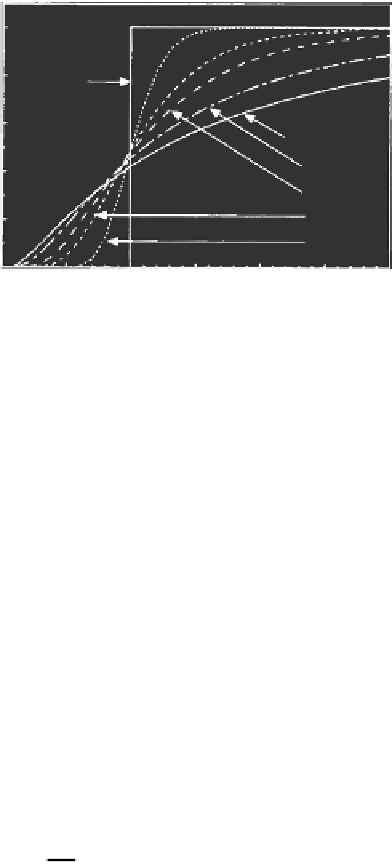Agriculture Reference
In-Depth Information
1.0
Piston
flow
0.8
0.6
P
= 1
2
5
10
50
0.4
0.2
0
0
1
2
3
V/V
o
FIGURE 3.10
Relative concentration (
C
/
C
o
) versus pore volume (
V
/
V
o
) based on the Lindstrom et al. solution
for
R
= 1 and
P
= 1. (From Selim and Amacher, 1997. With permission.)
number
P
are shown in Figure 3.10. As
P
decreases, the extent of spreading
increases due to increased apparent dispersion coefficient
D
or decrease in
v
. Moreover, as
P
→ ∞ (
D
→ 0 or
v
→ ∞) the breakthrough resembles that for
a step function at one pore volume (
V
/
V
o
= 1) and represents the condition of
piston-type flow or convection only.
3.8 Other Exact Solutions
In addition to the exact solutions presented above for the CDE, several other
exact solutions are also available. Specifically, a number of solutions are
available for the CDE having the form:
∂
∂
C
t
2
C
z
∂
∂
−−
C
z
∂
∂
R
=D
−
v
aC
a
(3.56)
1
2
2
which includes a linear (reversible) retention term as described by the retar-
dation factor
R
(of Equation 3.25). In addition, Equation 3.40 includes a first-
order irreversible reaction term, with
a
1
the associated rate coefficient (h
-1
).
In addition, it also includes a zero-order sink source/source term having a
constant rate of loss
a
2
(or gain for negative
a
2
). Subject to different sets of
boundary conditions (Equations 3.26 to 3.32) for soil columns of finite or semi-
infinite lengths, a number of exact solutions to Equation 3.40 are available
in the literature (Carslaw and Jaeger, 1959; Ozisik, 1968; Selim and Mansell,
1976; van Genuchten and Alves 1982). However, most retention mechanisms




Search WWH ::

Custom Search